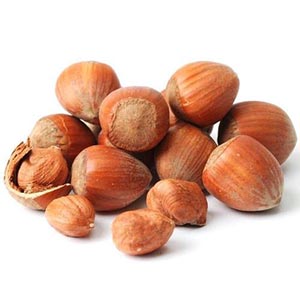Hazelnuts Nutrition facts
Hazelnuts are sweet, and incredibly nutritious edible kernels from the "birch" or Betulaceae family of trees. “Filbert” (C.maxima) is similar in kind and related to the common hazel but only differing in having its nut entirely covered within tubular involucre. In Britain, both of these nuts are in general enjoyed as "cobnuts."
Scientific name: Corylus avellana.
The hazel is a small deciduous tree that originated in southern Europe and Turkey. It is now being cultivated in many regions of the world, including the USA as a major commercial crop.
 |
| Hazelnuts, shelled-close up view. |
Hazelnuts appear in clusters on the tree. Each fruit (nut) is held inside the short, leafy involucre ("capsule"), covering about three-quarters of the kernel. The yellow-brown kernel is roughly spherical in shape, about 1.5-2 cm long and 1.2 -2 cm across, and featuring a light scar at its base. They generally fall down out of this leafy involucre (capsule) once ripen, after about 7-8 months after pollination.
Hazelnut oil, extracted from the kernels, has been used as a base or carrier oil in medicine and aromatherapy.
9 Amazing Health Benefits of Hazelnuts
Hazelnuts are very high in energy and loaded with many health-benefiting nutrients that are essential for optimum health. 100 g nuts carry 628 calories.
The nuts are rich in mono-unsaturated fatty acids like oleic as well as essential fatty acid, linoleic acid that helps in decreasing LDL (bad cholesterol) and rise in HDL (good cholesterol) levels in the blood. Research studies suggest that the Mediterranean diet plentiful in monounsaturated fatty acids contributes to preventing coronary artery disease, and strokes by favoring a healthy blood lipid profile.
The nuts are rich in dietary fiber, vitamins, and minerals and are packed with numerous health-promoting phytochemicals. Altogether, they help protect from diseases and cancers.
Hazels are exceptionally rich in folate, which is a unique feature for the nuts. 100 g fresh nuts carry 113µg; that is, about 28% of recommended the daily intake of this vitamin. Folate is an essential B-complex vitamin that helps prevent megaloblastic anemia, and most importantly, neural tube defects in the newborn. Good news for the expectant mothers!
Hazel nuts are an excellent source of vitamin-E; contain about 15 g per 100 g (providing 100% of RDA). Vitamin-E is a powerful lipid soluble antioxidant required for maintaining the integrity of mucosa and skin by protecting it from harmful "free oxygen radicals".
The nuts, like in almonds, are free from gluten, and therefore, safe alternative food sources that can be employed in the preparation of gluten-free food formulas for gluten-sensitive, wheat allergic, and celiac disease patients.
Besides being rich in folates, they are packed with many other important B-complex groups of vitamins such as riboflavin, niacin, thiamin, pantothenic acid, and pyridoxine (vitamin B-6).
Cobnuts are rich sources of minerals like manganese, potassium, calcium, copper, iron, magnesium, zinc, and selenium. Copper and manganese are essential co-factors for antioxidant enzyme, superoxide dismutase. Iron helps prevent microcytic-anemia. Magnesium and phosphorus are vital components of bone metabolism.
Hazelnut oil has a nutty aroma and has excellent astringent properties. It helps keep skin well protected from dryness. The oil has also been used in cooking and as a “carrier or base oil” in traditional medicines in massage therapy, aromatherapy, and in the pharmaceutical and cosmetic industry.
| Principle | Nutrient Value | Percent of RDA |
|---|---|---|
| Energy | 628 Kcal | 31% |
| Carbohydrates | 16.7 g | 13% |
| Protein | 14.95g | 26.5% |
| Total Fat | 60.75 g | 202% |
| Cholesterol | 0 mg | 0% |
| Dietary Fiber | 9.7 g | 25.5% |
| Vitamins | ||
| Folates | 113 µg | 28% |
| Niacin | 1.8 mg | 11% |
| Pantothenic acid | 0.918 mg | 18% |
| Pyridoxine | 0.563 mg | 43% |
| Riboflavin | 0.113 mg | 9% |
| Thiamin | 0.643 mg | 53.5% |
| Vitamin A | 20 IU | <1% |
| Vitamin C | 6.3 mg | 10.5% |
| Vitamin E | 15 mg | 100% |
| Vitamin K | 14.2 µg | 12% |
| Electrolytes | ||
| Sodium | 0 mg | 0% |
| Potassium | 680 mg | 14% |
| Minerals | ||
| Calcium | 114 mg | 11% |
| Copper | 1.725 mg | 192% |
| Iron | 4.7 mg | 59% |
| Magnesium | 163 mg | 41% |
| Manganese | 6.17 mg | 268% |
| Phosphorus | 290 mg | 41% |
| Zinc | 2.45 mg | 22% |
| Phyto-nutrients | ||
| Carotene-α | 3 µg | -- |
| Carotene-ß | 11 µg | -- |
| Lutein-zeaxanthin | 92 µg | -- |
Selection and storage
Hazelnuts can be available in the market year-round. In the stores, several different kinds of hazels are sold like shelled, unshelled, salted, sweetened, or milled (powder), etc.
Buy unshelled (with the outer shell) raw nuts instead of processed ones. The nuts should feature bright brown-yellow, compact, uniform in size, and feel heavy in hand. They should be free from surface cracks, molds, and spots and free from rancid smell.
Unshelled hazels can be stored in a cool and dry place for years. To store shelled (without their outer coat) nuts, keep them inside an airtight container and place them in the refrigerator to avoid turning rancid.
Culinary uses
Hazelnuts are eaten on their own, roasted, salted, or sweetened. Hazels, as well as filberts, are nutty yet pleasantly sweet in taste.
Here are some serving tips:
 |
| Cake with hazelnut praline. Photo: jules |
Hazels are widely employed in the confectionery, as an addition to chocolates, biscuits, sweets, and cakes.
They are also used to make hazelnut butter, which is a popular alternative for peanut allergy sufferers. It is also less salty in taste. It contains, however, more fat content than soy or peanut butter.
Safety profile
Hazelnut allergy is a type-1 (Ig-E mediated) hypersensitivity response in some people to food substances prepared using these nuts. In general, the allergic reaction tends to be precipitated by exposure to tree pollen rather than consuming hazelnut itself.
The allergic symptoms, known as "oral allergy syndrome," may include itchiness around lips, tongue, and throat followed by swelling of lips and throat leading to breathing difficulty. Often, cross-reactions to certain other nuts, seeds, fruits, and vegetables are common. Individuals with known allergies to them are, therefore, advised to avoid any food preparations that contain hazelnut products. (Medical Disclaimer).
≻≻-Back to Nuts and seeds from Hazelnuts. Visit here for an impressive list of nuts with complete illustrations of their nutrition facts and health benefits.
≻≻-Back to Home page.
Further Resources:
Stanford School of Medicine Cancer information Page- Nutrition to Reduce Cancer Risk.